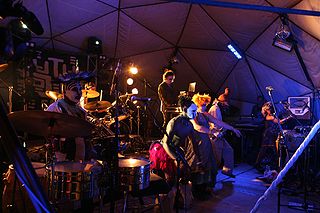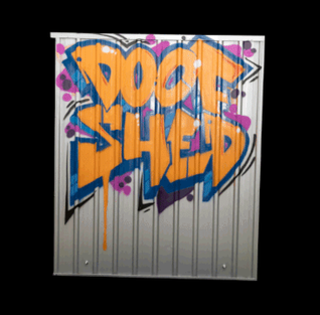House is a genre of electronic dance music characterized by a repetitive four-on-the-floor beat and a typical tempo of 120-130 beats per minute as a re-emergence of 1970s disco. It originated in the Black queer community in Chicago. It was created by DJs and music producers from Chicago's underground club culture and evolved slowly in the early/mid 1980s as DJs began altering disco songs to give them a more mechanical beat. By early 1988, House became mainstream and supplanted the typical 80s music beat.

The Love Parade was an electronic dance music festival and technoparade that originated in 1989 in West Berlin, Germany. It was held annually in Berlin from 1989 to 2003 and in 2006, then from 2007 to 2010 in the Ruhr region. Events scheduled for 2004 and 2005 in Berlin and for 2009 in Bochum were canceled.
Trance is a genre of electronic dance music that emerged from EBM in Frankfurt, Germany, in the late 1980s and early 1990s, and quickly spread throughout Europe.

A rave is a dance party at a warehouse, club, or other public or private venue, typically featuring performances by DJs playing electronic dance music. The style is most associated with the early 1990s dance music scene when DJs played at illegal events in musical styles dominated by electronic dance music from a wide range of sub-genres, including drum and bass, dubstep, trap, break, happy hardcore, trance, techno, hardcore, house, and alternative dance. Occasionally live musicians have been known to perform at raves, in addition to other types of performance artists such as go-go dancers and fire dancers. The music is amplified with a large, powerful sound reinforcement system, typically with large subwoofers to produce a deep bass sound. The music is often accompanied by laser light shows, projected coloured images, visual effects and fog machines.
Psychedelic trance, psytrance, or psy is a subgenre of trance music characterized by arrangements of rhythms and layered melodies created by high tempo riffs. The genre offers variety in terms of mood, tempo, and style. Some examples include full on, darkpsy, forest, minimal (Zenonesque), hitech psy, progressive, suomi, psy-chill, psycore, psybient, psybreaks, or "adapted" tracks from other music genres. Goa trance preceded psytrance; when digital media became more commonly used psytrance evolved. Goa continues to develop alongside the other genres.
Detroit techno is a type of techno music that generally includes the first techno productions by Detroit-based artists during the 1980s and early 1990s. Prominent Detroit techno artists include Juan Atkins, Eddie Fowlkes, Derrick May, Jeff Mills, Kevin Saunderson, Blake Baxter, Drexciya, Mike Banks, James Pennington and Robert Hood. Artists like Terrence Parker and his lead vocalist, Nicole Gregory, set the tone for Detroit's piano techno house sound.
Goa trance is an electronic dance music style that originated in the early 1990s in the Indian state of Goa. Goa trance often has drone-like basslines, similar to the techno minimalism of 21st century psychedelic trance (psytrance). Psychedelic trance developed from Goa trance. The typically long songs built on progressive beat changes are said to put the listener in a “trance”.
Tech house is a subgenre of house music that combines stylistic features of techno with house. The term tech house developed as a shorthand record store name for a category of electronic dance music that combined musical aspects of techno, such as "rugged basslines" and "steely beats", with the harmonies and grooves of progressive house. The music originally had a clean and minimal production style that was associated with techno from Detroit and the UK.

A free party is a party "free" from the restrictions of the legal club scene, similar to the free festival movement. It typically involves a sound system playing electronic dance music from late at night until the time when the organisers decide to go home. A free party can be composed of just one system or of many and if the party becomes a festival, it becomes a teknival. This typically means that drugs are readily available. The word free in this context is used both to describe the entry fee and the lack of restrictions and law enforcement.
Teknivals are large free parties which take place for several days. They take place most often in Europe and are often illegal under various national or regional laws. They vary in size from dozens to thousands of people, depending on factors such as accessibility, reputation, weather, and law enforcement. The parties often take place in venues far away from residential areas such as squatted warehouses, empty military bases, beaches, forests or fields. The teknival phenomenon is a grassroots movement which has grown out of the rave, punk, reggae sound system and UK traveller scenes and spawned an entire subculture. Summer is the usual season for teknivals.

Earthcore was an Australian outdoor dance music festival and electronic music event. The outdoor events were generally held in forest environments around Victoria, Australia, with some events held in Queensland and overseas in New Caledonia. Earthcore has operated since 1992. After the Earthcore Carnival that ran from the 28th to 30 November 2008, Earthcore took a hiatus before returning for their 20-year anniversary celebration in November 2013.
Electronic dance music (EDM) is a broad range of percussive electronic music genres originally made for nightclubs, raves, and festivals. It is generally produced for playback by DJs who create seamless selections of tracks, called a DJ mix, by segueing from one recording to another. EDM producers also perform their music live in a concert or festival setting in what is sometimes called a live PA. Since its inception EDM has expanded to include a wide range of subgenres.

Tribal Gathering is the original British electronic dance music festival that between 1993 and 2004 catered for different types of dance music cultures such as techno, house and drum & bass. After 18 years, Tribal Gathering returns in 2023 for a two-day event to celebrate its 30th anniversary.

Dance music is music composed specifically to facilitate or accompany dancing. It can be either a whole piece or part of a larger musical arrangement. In terms of performance, the major categories are live dance music and recorded dance music. While there exist attestations of the combination of dance and music in ancient history, the earliest Western dance music that we can still reproduce with a degree of certainty are old-fashioned dances. In the Baroque period, the major dance styles were noble court dances. In the classical music era, the minuet was frequently used as a third movement, although in this context it would not accompany any dancing. The waltz also arose later in the classical era. Both remained part of the romantic music period, which also saw the rise of various other nationalistic dance forms like the barcarolle, mazurka, ecossaise, ballade and polonaise.
German electronic music is a broad musical genre encompassing specific styles such as Electroclash, trance, krautrock and schranz. It is widely considered to have emerged in the late 1960s and early 1970s, becoming increasingly popular in subsequent decades. Originally minimalistic style of electronic music developed into psychedelic and prog rock aspects, techno and electronic dance music. Notable artists include Kraftwerk, Can, Tangerine Dream and Deutsch Amerikanische Freundschaft. German electronic music contributed to a global transition of electronic music from underground art to an international phenomenon, with festivals such as Love Parade, Winterworld and MayDay gaining prominence alongside raves and clubs.
Every Picture Tells a Story were a series of all-night electronic dance music festivals held at different venues in Melbourne. In 1991 Heidi John and Richard John started a series of warehouse, rave parties. In 1993 they formed the Melbourne Underground Development (M.U.D.) crew with Phil Woodman. From 1993 to 1997 the parties were held at the Global Village in suburban, Footscray. Some 21 such parties were held until the year 2000. A one-off Every Picture Tells a Story event was held in April 2010.
Techno is a genre of electronic dance music which is generally produced for use in a continuous DJ set, with tempos being in the range of 120 to 150 beats per minute (BPM). The central rhythm is typically in common time (4/4) and often characterized by a repetitive four on the floor beat. Artists may use electronic instruments such as drum machines, sequencers, and synthesizers, as well as digital audio workstations. Drum machines from the 1980s such as Roland's TR-808 and TR-909 are highly prized, and software emulations of such retro instruments are popular.
The Maitreya Festival is a large outdoor music festival held yearly in Melbourne, Australia. The festival generally plays a mixture of psytrance and techno, and has a large associated Alternative community. It has grown considerably in size over its 10-year history, with the event starting with 2000 people, building to attract 10,000 attendees in 2015, its 9th year of operation. In terms of outdoor electronic music events (commonly known as Doofs or Bush Doofs in Australia, this makes it the third biggest after Rainbow Serpent and Earthcore. It is the largest psytrance event in Australia. Maitraya has been said as some to be more “Ideaologically in tune” and less commercial.

The Doof Shed is a small, portable nightclub created by twins Harry Nathan and Evangelos "Boonie" Labrakis. It holds a Guinness World Record for being the smallest nightclub in the world, measuring 1.53 by 0.74 metres and fitting seven people. It beat previous record holder, Club 28 in Rotherham, England.
Belgian hardcore techno is an early style of hardcore techno that emerged from new beat as EBM and techno influences became more prevalent in this genre. This particular style has been described as an "apocalyptic, almost Wagnerian, bombastic techno", due to its use of dramatic orchestral stabs and menacing synth tones that set it apart from earlier forms of electronic dance music. It flourished in Belgium and influenced the sound of early hardcore from Netherlands, Germany, Italy, UK and North America during the early-1990s, as a part of the rave movement during that period.







